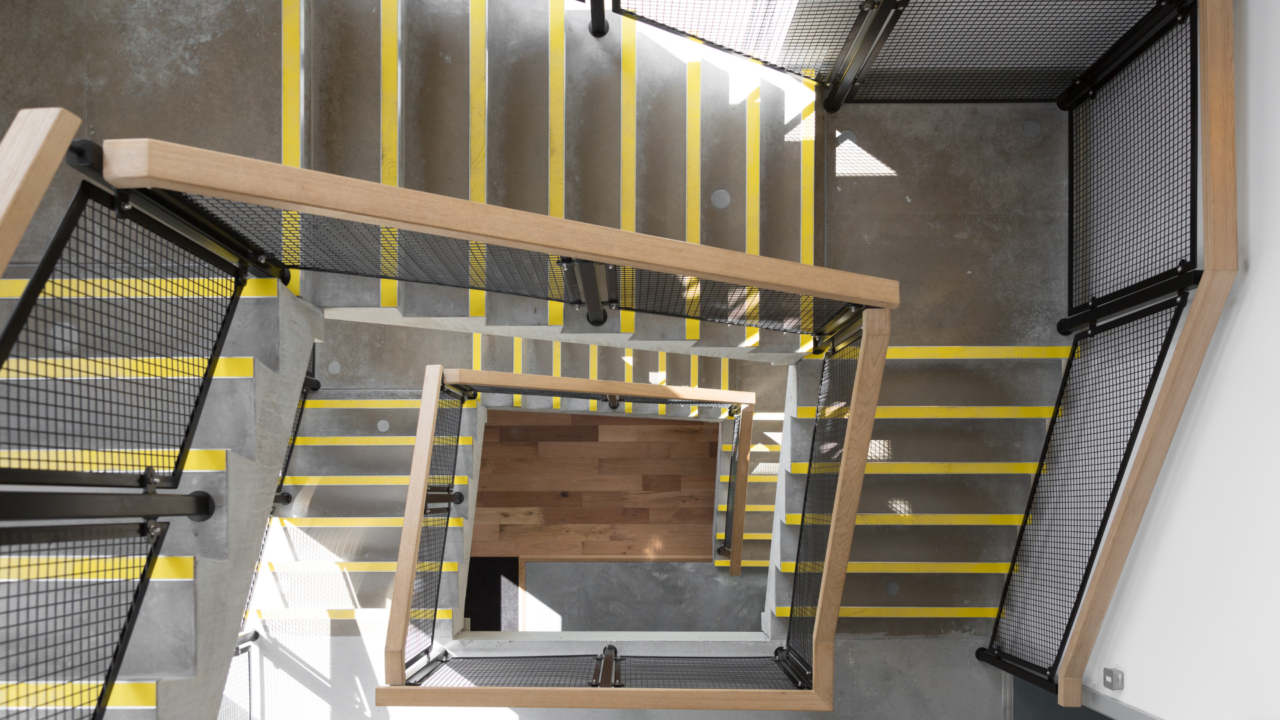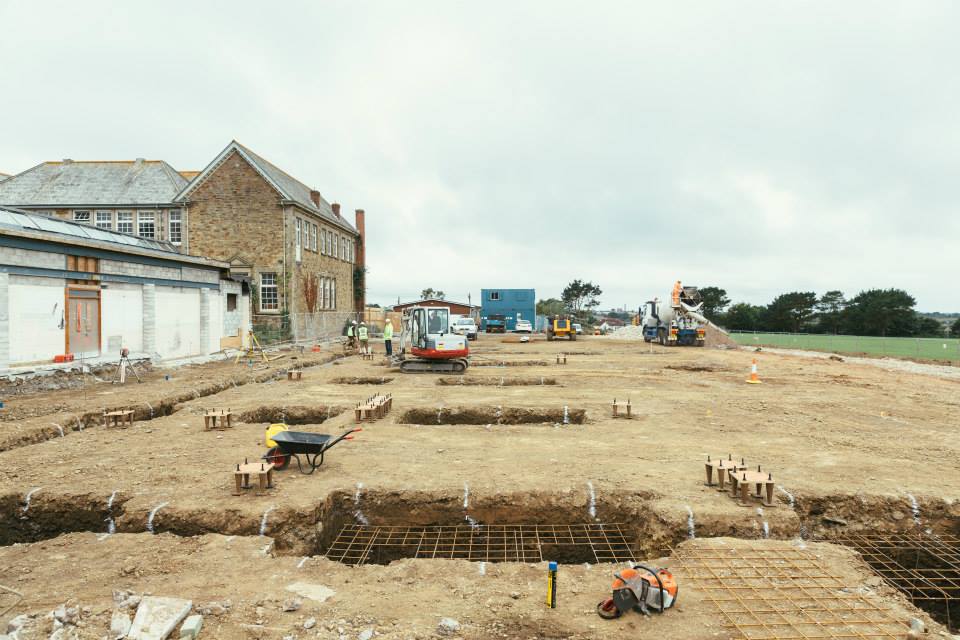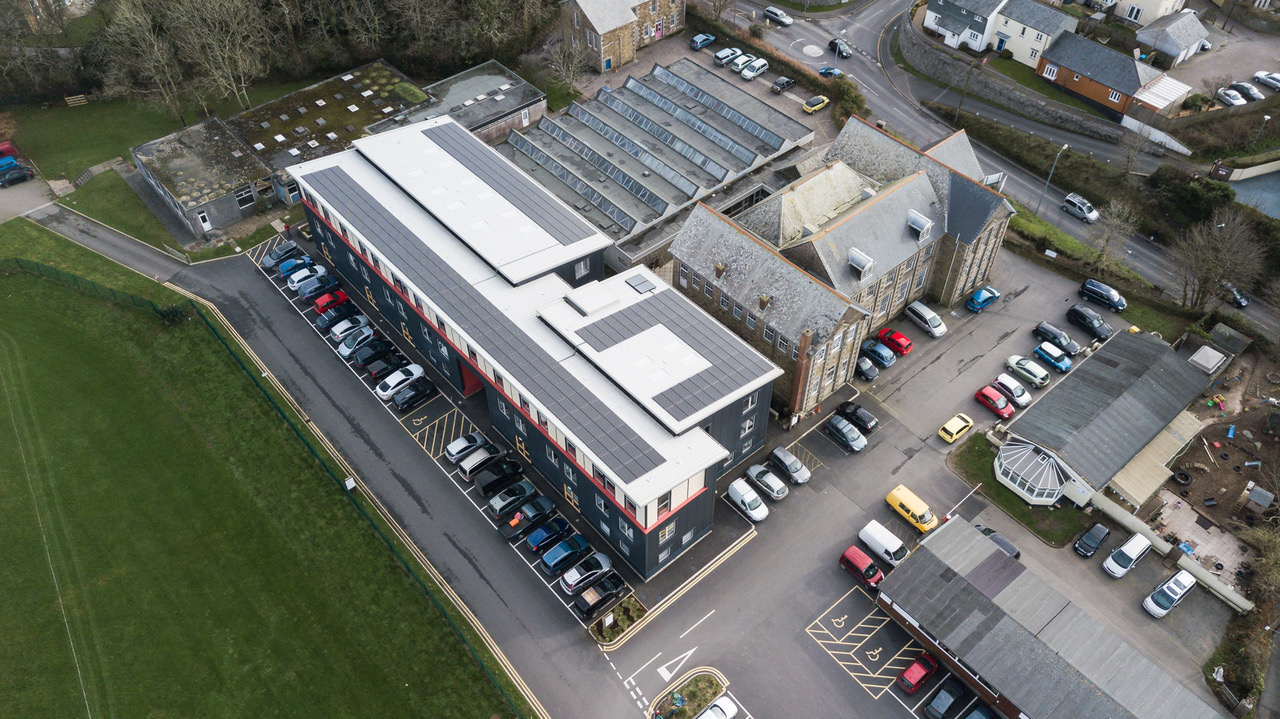- Posted on April 5th, 2022
Creative Kernow : Reuse, Recycle, Redevelop

In 2002, ACT (Cornwall Arts Centre Trust which became known as Creative Kernow) began developing the former Redruth Grammar School in Redruth, Cornwall into offices and managed workspaces. The premises were formally purchased by ACT in 2005, and over time the former classrooms were converted into studios for 100 artists and makers. Krowji was created with the purpose of raising the profile, capacity and profitability of the creative industries in Cornwall and to give them a business advantage in regional, national and international markets.
The opportunity arose through working with Cornwall Council, Cornwall Development Company, Arts Council England, Redruth Town Council and ERDF (European Regional Development Fund).
Sustainable redevelopment of Krowji site and Percy Williams Building

Kirstin Prisk Photography
The project’s aim was to provide the high-quality business infrastructure needed to support the growth of the creative sector in Cornwall and to add significant extra floor area to the existing workspace cluster at Krowji.
Krowji (meaning workshop or shed in the Cornish language) is an up-cycled former grammar school in Redruth. Since opening in 2005, the site has undergone two redevelopment and expansion stages aided by ERDF funding, making efficient use of brownfield sites that had been previously occupied by neglected buildings.
The flagship scheme, Krowji Phase 1 (2015), involved the development of the Percy Williams Building to offer 50 new studio spaces. This was followed by Krowji Phase 2 which opened in 2020, an extension of the Percy Williams Building which added 20 new studios to the complex. The aim of the project was to exceed current standards for sustainable development and provide simple design strategies that will maintain user comfort for all in a low carbon development to achieve the BREEAM Excellent standard.
For both phases, the building redevelopments were certified with an “Excellent” rating during their BREEAM assessment, showing that they were exemplary in demonstrating how innovative design and use of materials can deliver a building which is highly efficient in energy usage.
Making New of Old
The build was based around the demolition of dilapidated school blocks alongside the two-year construction of custom-built buildings, to meet the need for providing more studio spaces that were modern and purpose-built to accommodate creative industries practitioners.
The aim was to make buildings as sustainable as possible using recycled local materials where possible, and structuring a reduced need for energy consumption, carefully designed ventilation systems and high levels of insulation. This expansion doubles the capacity of the site, expanding the Krowji community to 200 artists, makers and creative businesses.

Aerial Shot post phase 1 – Luke Holland Photography
The design team behind the Percy Williams Building Phases 1 and 2 focused on energy and carbon hungry structures and systems. They took into consideration the orientation of the buildings, utilising high thermal mass, high performance glazing, natural passive ventilation and high levels of insulation greater than those required by the standard building regulations of the time.
Locally sourced and recycled construction materials were used as well as materials from the demolition of existing rundown buildings wherever possible. Permeable paving and soakaways were created to future-proof against flooding and more extreme rainfall. Low water usage fittings were installed in facilities and rainwater harvesting for irrigation as a nod to the ERDF toolkit.
The Phase 2 summative assessment report outlined
“In terms of the ERDF horizontal principles, sustainability is core to Phase 2 and the building is intended to be one which is economic to manage and maintain (and more so than the former Science Block). The building is fully accessible, and the studios can be tailored to individual requirements, supporting equal opportunities and non- discrimination. On a wider point, Krowji’s letting policy is to be as inclusive of all creative practices as far as possible and practicable.”
Solar panels, air source heat pumps, and EV chargers
Previously, before the ERDF-funded redevelopment phases of Krowji’s Percy Williams Building, Creative Kernow did not have provisions to generate energy or heating onsite. With Phase 1 (2015) and Phase 2 (2020) came the roof solar panel installation (60kw in 2015, a further 60kw in 2020).
New air source heat pumps were also installed during both phases of redevelopment in 2015 and 2020 so, together with the solar thermal energy generated from the PV panels, we were able to heat the water supply to the tenanted Percy Williams Building. Where previously there was none, 6 EV chargers were installed in 2020 as part of the Phase 2 project, making up 5.4% of our onsite parking spaces.
We sell our solar generated electricity to the grid which provides us with income, while the water in the Percy Williams is heated via the air source heat pumps, allowing costs to be cut.
Obtaining BREEAM certification
Planned as part of the construction of Phases 1 and 2 of the Percy Williams Building was to get BREEAM certification. We achieved BREEAM “Excellent” rating on both Phase 1 and Phase 2 buildings that were opened
We undertook an assessment before the opening of each redevelopment phase and acquired certification as planned by Creative Kernow’s sustainability plans for the buildings.
Granting assurance that buildings are exemplary in demonstrating how innovative design and use of materials can deliver a building which is highly efficient in energy usage.
Landscaping
Creating external green spaces on the site benefit tenants’ wellbeing and sense of community, and increases biodiversity of plant life and wildlife.
Onsite landscaping involved encouraging biodiversity through the planting of many native trees and shrubs and wildflower patches, installing bird and bat boxes, and using reclaimed local stone from Falmouth harbour. The courtyard features carefully sourced picnic benches made with 100% recycled plastic. We were supported by Chris Nixon (artist tenant and gardener), Iron Orchid (landscape designer)
CLASH and Creative Kernow’s CLASH group
In 2020, Cultivator (part of the Creative Kernow group) formed CLASH – the Climate and Sustainability Hive for Cornwall, a platform for skills and expertise sharing and discussion – a ‘clash’ of forward-thinking ideas on integrating sustainability into creative business practice.
The internal Creative Kernow CLASH staff task force meets sporadically to discuss internal organisational sustainability practice with an attempt to engage with the UN Climate Development Goals where possible.
CLASH came about partly in response to Covid, Cultivator recognised the opportunity to do business differently and to put sustainable development principles at the heart of the creative and cultural sector. Using CLASH’s affiliation with GoodFest based in Cornwall, talks and skills development workshops were hosted for audiences and engagement with designers and creative practitioners. CLASH is still in its early stages in terms of measuring impact and reach.
This work was supported by Jane Sutherland (Cultivator Director), Laura Giles (Screen Cornwall Director and Cultivator Business Advisor), Fiona Wotton (CEO).
Header Image credit: Krowji-Percy-Williams-General-Views
